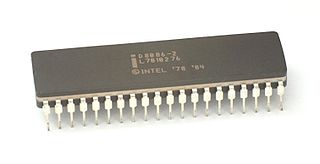
x86 is a family of complex instruction set computer (CISC) instruction set architectures initially developed by Intel based on the Intel 8086 microprocessor and its 8088 variant. The 8086 was introduced in 1978 as a fully 16-bit extension of Intel's 8-bit 8080 microprocessor, with memory segmentation as a solution for addressing more memory than can be covered by a plain 16-bit address. The term "x86" came into being because the names of several successors to Intel's 8086 processor end in "86", including the 80186, 80286, 80386 and 80486 processors. Colloquially, their names were "186", "286", "386" and "486".
In computing, Streaming SIMD Extensions (SSE) is a single instruction, multiple data (SIMD) instruction set extension to the x86 architecture, designed by Intel and introduced in 1999 in their Pentium III series of central processing units (CPUs) shortly after the appearance of Advanced Micro Devices (AMD's) 3DNow!. SSE contains 70 new instructions, most of which work on single precision floating-point data. SIMD instructions can greatly increase performance when exactly the same operations are to be performed on multiple data objects. Typical applications are digital signal processing and graphics processing.
The SSE5 was a SIMD instruction set extension proposed by AMD on August 30, 2007 as a supplement to the 128-bit SSE core instructions in the AMD64 architecture.
Advanced Vector Extensions (AVX) are extensions to the x86 instruction set architecture for microprocessors from Intel and Advanced Micro Devices (AMD). They were proposed by Intel in March 2008 and first supported by Intel with the Sandy Bridge processor shipping in Q1 2011 and later by AMD with the Bulldozer processor shipping in Q3 2011. AVX provides new features, new instructions, and a new coding scheme.

Intel Core is a line of streamlined midrange consumer, workstation and enthusiast computer central processing units (CPUs) marketed by Intel Corporation. These processors displaced the existing mid- to high-end Pentium processors at the time of their introduction, moving the Pentium to the entry level. Identical or more capable versions of Core processors are also sold as Xeon processors for the server and workstation markets.

Xeon Phi was a series of x86 manycore processors designed and made by Intel. It was intended for use in supercomputers, servers, and high-end workstations. Its architecture allowed use of standard programming languages and application programming interfaces (APIs) such as OpenMP.
AVX-512 are 512-bit extensions to the 256-bit Advanced Vector Extensions SIMD instructions for x86 instruction set architecture (ISA) proposed by Intel in July 2013, and implemented in Intel's Xeon Phi x200 and Skylake-X CPUs; this includes the Core-X series, as well as the new Xeon Scalable Processor Family and Xeon D-2100 Embedded Series. AVX-512 consists of multiple extensions that may be implemented independently. This policy is a departure from the historical requirement of implementing the entire instruction block. Only the core extension AVX-512F is required by all AVX-512 implementations.
An AI accelerator is a class of specialized hardware accelerator or computer system designed to accelerate artificial intelligence and machine learning applications, including artificial neural networks and machine vision. Typical applications include algorithms for robotics, Internet of Things, and other data-intensive or sensor-driven tasks. They are often manycore designs and generally focus on low-precision arithmetic, novel dataflow architectures or in-memory computing capability. As of 2018, a typical AI integrated circuit chip contains billions of MOSFET transistors. A number of vendor-specific terms exist for devices in this category, and it is an emerging technology without a dominant design.

AMD Instinct is AMD's brand of professional GPUs. It replaced AMD's FirePro S brand in 2016. Compared to the Radeon brand of mainstream consumer/gamer products, the Instinct product line is intended to accelerate deep learning, artificial neural network, and high-performance computing/GPGPU applications.
Sunny Cove is a codename for a CPU microarchitecture developed by Intel, first released in September 2019. It succeeds the Palm Cove microarchitecture and is fabricated using Intel's 10 nm process node. The microarchitecture is implemented in 10th-generation Intel Core processors for mobile and third generation Xeon scalable server processors. 10th-generation Intel Core mobile processors were released in September 2019, while the Xeon server processors were released on April 6, 2021.
Rocket Lake is Intel's codename for its 11th generation Core microprocessors. Released on March 30, 2021, it is based on the new Cypress Cove microarchitecture, a variant of Sunny Cove backported to Intel's 14 nm process node. Rocket Lake cores contain significantly more transistors than Skylake-derived Comet Lake cores.

Alder Lake is Intel's codename for the 12th generation of Intel Core processors based on a hybrid architecture utilizing Golden Cove performance cores and Gracemont efficient cores. It is fabricated using Intel's Intel 7 process, previously referred to as Intel 10 nm Enhanced SuperFin (10ESF). The 10ESF has a 10%-15% boost in performance over the 10SF used in the mobile Tiger Lake processors. Intel officially announced 12th Gen Intel Core CPUs on October 27, 2021. Intel officially announced 12th Gen Intel Core mobile CPUs and non-K series desktop CPUs on January 4, 2022. Intel officially announced the launch of Alder Lake-P and -U series on February 23, 2022, and Alder Lake-HX series on May 10, 2022.
Golden Cove is a codename for a CPU microarchitecture developed by Intel and released in November 2021. It succeeds four microarchitectures: Sunny Cove, Skylake, Willow Cove, and Cypress Cove. It is fabricated using Intel's Intel 7 process node, previously referred to as 10 nm Enhanced SuperFin (10ESF).
This page is based on this
Wikipedia article Text is available under the
CC BY-SA 4.0 license; additional terms may apply.
Images, videos and audio are available under their respective licenses.




